Exploring the Types of Mosquito Traps and How They Collect Data
Why are there several different types of mosquito surveillance traps? This blog will provide a brief overview of seven mosquito surveillance tools, each with its advantages, depending upon what specific information is desired. Adult mosquito surveillance programs include the weekly trapping of adult mosquitoes by dividing an area such as a city, county, or industrial facility into control zones and utilizing traps that are most meaningful in each zone. Understanding a community’s environment and history, along with the implementation of the right trap(s), will provide a better picture of the mosquito species in a given area and if a potential disease threat exists.
CDC Light Trap
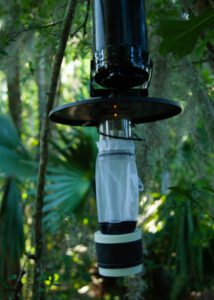
CDC light traps are an industry standard in adult mosquito surveillance. Developed by the Center for Disease Control (CDC) and Prevention, these portable traps are powered by a 6V battery with a motorized fan and a mosquito collection cup. CDC traps are portable and can be utilized in a variety of ways, but the most common model is accompanied by a small light and a carbon dioxide (CO2) bait source. The flow of CO2 emanating from the trap will lure adult mosquitoes by simulating the exhaled respiratory gasses of birds or mammals. Mosquitoes attracted to the trap are drawn in at the top and forced downward by the fan into the collection net where they cannot escape. Many mosquito species are active during the evening, and therefore CDC traps are typically deployed at dusk and collected after dawn the following day. The live-trapped mosquitoes can then be analyzed at the lab.
BG-Sentinel Trap
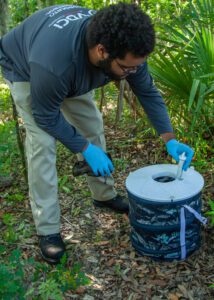 The BG-Sentinel trap was designed with two specific mosquito species in mind, Aedes albopictus (Asian Tiger mosquito) and Aedes aegypti (Yellow Fever mosquito). The two species are known to vector dengue, chikungunya, Zika, and yellow fever viruses and thrive in urban environments. Both species use natural and artificial containers for breeding, making them notoriously difficult to catch in significant numbers. The BG-Sentinel trap is made of a tarp like material, about the size of a 5-gallon bucket, and utilizes an attractant such as Octenol lure, human scent lure, or carbon dioxide (CO2). A funnel located at the top of the trap leads mosquitoes to an electric fan (outlet or battery powered) that pulls them into a collection net. The BG-Sentinel traps do well at catching the elusive Aedes species when placed in the proper areas and with the appropriate attractants.
The BG-Sentinel trap was designed with two specific mosquito species in mind, Aedes albopictus (Asian Tiger mosquito) and Aedes aegypti (Yellow Fever mosquito). The two species are known to vector dengue, chikungunya, Zika, and yellow fever viruses and thrive in urban environments. Both species use natural and artificial containers for breeding, making them notoriously difficult to catch in significant numbers. The BG-Sentinel trap is made of a tarp like material, about the size of a 5-gallon bucket, and utilizes an attractant such as Octenol lure, human scent lure, or carbon dioxide (CO2). A funnel located at the top of the trap leads mosquitoes to an electric fan (outlet or battery powered) that pulls them into a collection net. The BG-Sentinel traps do well at catching the elusive Aedes species when placed in the proper areas and with the appropriate attractants.
Gravid Traps
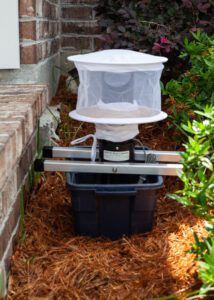
Gravid traps are designed to catch gravid (blood-fed) Culex species, such as Culex tarsalis or Culex pipiens, that are capable of transmitting West Nile virus, St. Louis Encephalitis, and both Western and Eastern Equine Encephalitis. Culex mosquitoes are attracted to the trap by the stagnant water placed under a battery-powered fan which blows mosquitoes into a collection container. The water contains a solution of organic material, often grass or hay, that has been left to sit for several days or longer and serves as an attractant by mimicking the naturally occurring stagnant water, where the Culex species often prefer to lay their eggs. If a trap is left at its location, the water attractant should always be drained on days that no trapping is occurring. For public health reasons, this is especially important if the trap is located near any residences since the trap will act as a breeding site if no collection container and battery are attached.
New Jersey Light Trap
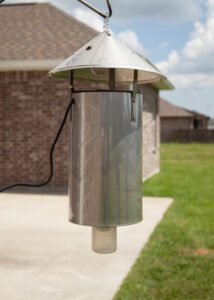
The New Jersey light trap is a generalized adult mosquito trap that is designed to capture a broad spectrum of mosquito species. This particular mosquito collection device is meant for a more permanent trap location as it needs to be firmly mounted about 5 to 6 feet above the ground and powered by an outlet. Dry ice can also be suspended directly above a New Jersey light trap in a vented container as an additional attractant. Due to the New Jersey light trap’s ability to catch a large variety of mosquito species, and in large quantities, it is a great tool for any mosquito control program. The broad survey of mosquito species caught can help determine relative mosquito populations for an area, identify local species of mosquito vectors, and assist technicians in finding local breeding sources. The attractants for this trap tend to entice more aggressive mosquito species. Nuisance mosquito control programs, in particular, may benefit from having a well-placed New Jersey light trap.
Autodissemination Trap (or lethal oviposition trap)
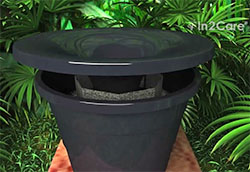 Lethal oviposition traps consist of small containers housing water laced with an attractive lure to bring in gravid mosquitoes seeking oviposition sites. The water within these traps is laced with an insecticide that prevents progeny from successfully emerging and a slow-acting adulticide which allows females to be released back into the environment and carry larvicides to other locations. Because these traps rely on specialized egg-laying behavior of invasive Aedes they are often deployed in small targeted area, need to be densely
Lethal oviposition traps consist of small containers housing water laced with an attractive lure to bring in gravid mosquitoes seeking oviposition sites. The water within these traps is laced with an insecticide that prevents progeny from successfully emerging and a slow-acting adulticide which allows females to be released back into the environment and carry larvicides to other locations. Because these traps rely on specialized egg-laying behavior of invasive Aedes they are often deployed in small targeted area, need to be densely
applied, and and require frequent inspection.
What About Ultraviolet (UV) Traps (Bug Zappers)?
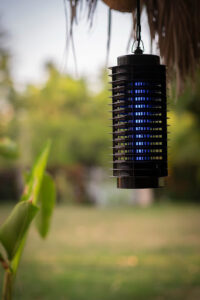 These traps use UV light to attract mosquitoes and other flying insects to an electrified grid or adhesive pad. However, mosquitoes aren’t really attracted to UV light in the way that other insects are.
These traps use UV light to attract mosquitoes and other flying insects to an electrified grid or adhesive pad. However, mosquitoes aren’t really attracted to UV light in the way that other insects are.
UV traps (bug zappers) tend to attract and kill many beneficial insects and do not control the females of most mosquito species very well, so I personally advise people to stay away from them.
How About Sticky Mosquito Traps?
These traps use a sticky surface to catch mosquitoes and other flying insects that are attracted to a light or chemical source. Most people have seen the Fly strips; that’s a bit what we’re referring to here. They’re not commonly used for mosquito surveillance collections; mostly because you get a good amount of other insects and it can be difficult to ID mosquitoes that are stuck to sticky strips.
Counting and Identification of Adult Mosquitoes
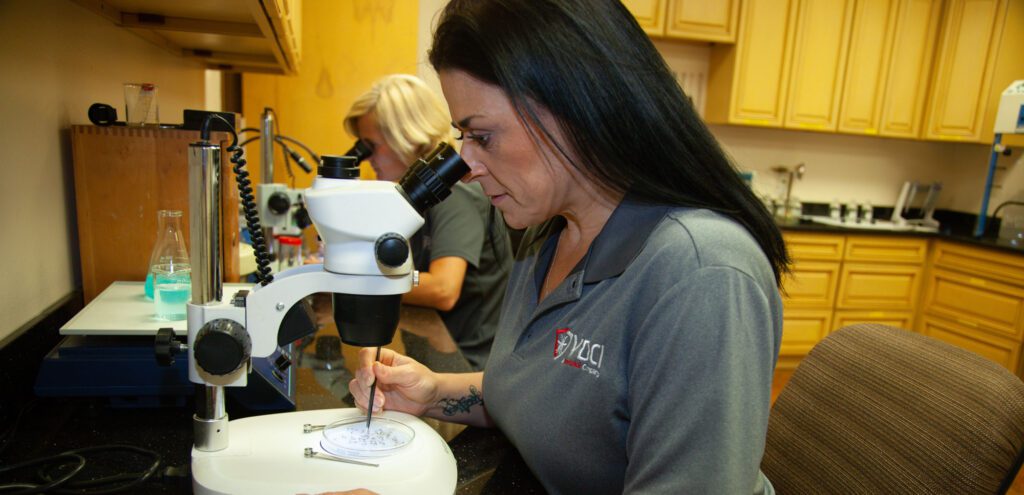
Adult mosquito surveillance traps play a key role in an Integrated Mosquito Management (IMM) program. The successful collection of adult mosquitoes provides mosquito management experts with an understanding of population levels as well as allows for the proper identification of species in a given area. Correctly identifying species and having knowledge of their bionomics offers insight into desired breeding habitats, active periods during the day/night, host preferences, and, maybe most importantly, which mosquito-borne diseases they can transmit. Additionally, understanding population levels can determine the severity of a nuisance mosquito outbreak. Collection, counting, and identification all aid in determining which abatement solutions should be employed to reduce the health risk to a community.
We are government partners in mosquito management. Contact us to learn how we can manage or support your mosquito surveillance program:
 Since 1992, Vector Disease Control International (VDCI) has taken pride in providing municipalities, mosquito abatement districts, military bases, industrial sites, planned communities, homeowners associations, and golf courses with the tools they need to run effective Integrated Tick and Mosquito Management programs. We are determined to protect the public health of the communities in which we operate. Our tick and mosquito management professionals have over 100 years of combined experience in the field of public health, specifically vector disease control. We strive to provide the most effective and scientifically sound mosquito surveillance and control programs possible based on an Integrated Mosquito Management (IMM) approach recommended by the American Mosquito Control Association (AMCA) and Centers for Disease Control and Prevention (CDC). VDCI is the only company in the country that can manage all aspects of an Integrated Tick and Mosquito Management program, from surveillance to disease testing to aerial applications in emergency response situations.
Since 1992, Vector Disease Control International (VDCI) has taken pride in providing municipalities, mosquito abatement districts, military bases, industrial sites, planned communities, homeowners associations, and golf courses with the tools they need to run effective Integrated Tick and Mosquito Management programs. We are determined to protect the public health of the communities in which we operate. Our tick and mosquito management professionals have over 100 years of combined experience in the field of public health, specifically vector disease control. We strive to provide the most effective and scientifically sound mosquito surveillance and control programs possible based on an Integrated Mosquito Management (IMM) approach recommended by the American Mosquito Control Association (AMCA) and Centers for Disease Control and Prevention (CDC). VDCI is the only company in the country that can manage all aspects of an Integrated Tick and Mosquito Management program, from surveillance to disease testing to aerial applications in emergency response situations.

